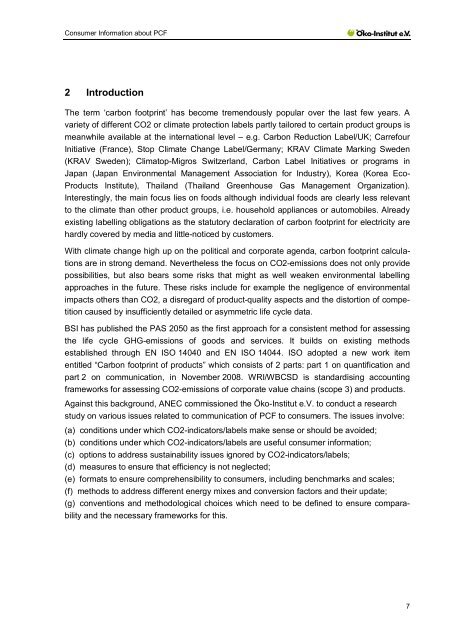Requirements on Consumer Information about Product ... - ANEC
Requirements on Consumer Information about Product ... - ANEC
Requirements on Consumer Information about Product ... - ANEC
Create successful ePaper yourself
Turn your PDF publications into a flip-book with our unique Google optimized e-Paper software.
C<strong>on</strong>sumer Informati<strong>on</strong> <strong>about</strong> PCF<br />
2 Introducti<strong>on</strong><br />
The term ‘carb<strong>on</strong> footprint’ has become tremendously popular over the last few years. A<br />
variety of different CO2 or climate protecti<strong>on</strong> labels partly tailored to certain product groups is<br />
meanwhile available at the internati<strong>on</strong>al level – e.g. Carb<strong>on</strong> Reducti<strong>on</strong> Label/UK; Carrefour<br />
Initiative (France), Stop Climate Change Label/Germany; KRAV Climate Marking Sweden<br />
(KRAV Sweden); Climatop-Migros Switzerland, Carb<strong>on</strong> Label Initiatives or programs in<br />
Japan (Japan Envir<strong>on</strong>mental Management Associati<strong>on</strong> for Industry), Korea (Korea Eco-<br />
<strong>Product</strong>s Institute), Thailand (Thailand Greenhouse Gas Management Organizati<strong>on</strong>).<br />
Interestingly, the main focus lies <strong>on</strong> foods although individual foods are clearly less relevant<br />
to the climate than other product groups, i.e. household appliances or automobiles. Already<br />
existing labelling obligati<strong>on</strong>s as the statutory declarati<strong>on</strong> of carb<strong>on</strong> footprint for electricity are<br />
hardly covered by media and little-noticed by customers.<br />
With climate change high up <strong>on</strong> the political and corporate agenda, carb<strong>on</strong> footprint calculati<strong>on</strong>s<br />
are in str<strong>on</strong>g demand. Nevertheless the focus <strong>on</strong> CO2-emissi<strong>on</strong>s does not <strong>on</strong>ly provide<br />
possibilities, but also bears some risks that might as well weaken envir<strong>on</strong>mental labelling<br />
approaches in the future. These risks include for example the negligence of envir<strong>on</strong>mental<br />
impacts others than CO2, a disregard of product-quality aspects and the distorti<strong>on</strong> of competiti<strong>on</strong><br />
caused by insufficiently detailed or asymmetric life cycle data.<br />
BSI has published the PAS 2050 as the first approach for a c<strong>on</strong>sistent method for assessing<br />
the life cycle GHG-emissi<strong>on</strong>s of goods and services. It builds <strong>on</strong> existing methods<br />
established through EN ISO 14040 and EN ISO 14044. ISO adopted a new work item<br />
entitled “Carb<strong>on</strong> footprint of products” which c<strong>on</strong>sists of 2 parts: part 1 <strong>on</strong> quantificati<strong>on</strong> and<br />
part 2 <strong>on</strong> communicati<strong>on</strong>, in November 2008. WRI/WBCSD is standardising accounting<br />
frameworks for assessing CO2-emissi<strong>on</strong>s of corporate value chains (scope 3) and products.<br />
Against this background, <strong>ANEC</strong> commissi<strong>on</strong>ed the Öko-Institut e.V. to c<strong>on</strong>duct a research<br />
study <strong>on</strong> various issues related to communicati<strong>on</strong> of PCF to c<strong>on</strong>sumers. The issues involve:<br />
(a) c<strong>on</strong>diti<strong>on</strong>s under which CO2-indicators/labels make sense or should be avoided;<br />
(b) c<strong>on</strong>diti<strong>on</strong>s under which CO2-indicators/labels are useful c<strong>on</strong>sumer informati<strong>on</strong>;<br />
(c) opti<strong>on</strong>s to address sustainability issues ignored by CO2-indicators/labels;<br />
(d) measures to ensure that efficiency is not neglected;<br />
(e) formats to ensure comprehensibility to c<strong>on</strong>sumers, including benchmarks and scales;<br />
(f) methods to address different energy mixes and c<strong>on</strong>versi<strong>on</strong> factors and their update;<br />
(g) c<strong>on</strong>venti<strong>on</strong>s and methodological choices which need to be defined to ensure comparability<br />
and the necessary frameworks for this.<br />
7
















